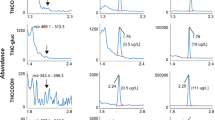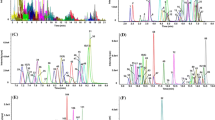Abstract
Marijuana is one of the most commonly used illicit substances. The high usage of this substance results in it being commonly encountered in clinical samples throughout the USA and Europe. Due to its wide availability and use, marijuana is also commonly encountered in forensic toxicology laboratories. The proposed method utilized an automated solid phase extraction (SPE) coupled to liquid chromatography/mass spectrometry (LC/MS). The automated SPE procedure was developed using Hysphere C8-EC sorbent, and the high performance liquid chromatography (HPLC) separation was performed using an Xterra MS C18 column with a total runtime of 10 min. The standard curves linearity generally fell between 6 and 500 ng/mL. The limits of detection ranged from 2 to 4 ng/mL, and the limits of quantitation ranged from 8 to 12 ng/mL. The bias and imprecision were determined using a simple analysis of variance (single factor). The results demonstrate bias as <11% and percent imprecision as <12% for all components at four quality control levels. This method has been in use for over 2 years and has been applied to numerous forensic samples. When compared to other published methods, it exceeds others in its simplicity and speed of analysis. This method takes advantage of robotics and automation for a total analysis time of 10 min, including sample preparation, separation, and detection.

Automated solid phase extraction unit coupled to a triple quadrupole mass spectrometer


Similar content being viewed by others
References
Department of Health and Human Services (2007) Results from the 2007 National Survey on Drug Use and Health: national findings. Substance abuse and mental health services administration. http://www.oas.samhsa.gov/nsduh/reports.htm#2k7
Drug Abuse Warning Network (DAWN) Annual report (2005): national estimates of drug-related emergency department visits. http://www.dawninfo.samhsa.gov
European Monitoring Center for Drugs and Drug Addiction Annual Report (2008) The state of the drug problem in Europe. http://www.emcdda.europa.eu
Woff K, Farrell M, Marsden J, Monteiro MG, Ali R, Welch S, Strang J (1999) A review of biological indicators of illicit drug use, practical considerations and clinical usefulness. Addiction 94:1279–1298
Maurer HH (2000) Screening procedure for simultaneous detection of several drug classes used for high throughput toxicological analyses and doping control. A review. Comb Chem High Throughput Screen 3:467–480
Karch SB (2007) Drug abuse handbook, 2nd edn. CRC Press, New York
Baselt RC (2002) Disposition of drugs and toxic chemicals in man, 6th edn. Biomedical Publications, California
Fellermeier M, Eisenreich W, Bacher A, Zenk MH (2001) Biosynthesis of cannabinoids. Incorporation experiments with 13C-labeled glucoses. Eur J Biochem 268(6):1596–1604
de Meijer EP, Baggata M, Carboni A, Crucitti P, Moliterni VM, Ranalli P, Mandolino G (2003) The inheritance of chemical phenotype in Cannabis sativa L. Genetics 163:335–346
Gustafson RA, Moolchan ET, Barnes A, Levine B, Huestis MA (2003) Validation method for the simultaneous determination of ∆9-tetrahydrocannabinol (THC), 11-hydroxy-THC and 11-nor-9-carboxy-THC in human plasma using solid phase extraction and gas chromatography-mass spectrometry with positive chemical ionization. J Chromatogr B Biomed Appl 798:145–154
Moore C, Rana S, Coulter C (2007) Simultaneous indentification of 2-carboxy-tetrahydrocannabinol, tetrahydrocannabinol, cannabinol, and cannabidiol in oral fluid. J Chromatogr B Biomed Appl 852:459–464
Moore C, Rana S, Coulter C, Vincent M, Soares J (2007) Detection of conjugated 11-nor-∆9-tetrahydrocannabinol-9-carboxylic acid in oral fluid. J Anal Toxicol 31:187–194
Huq S, Dixon A, Kelly K, Kallury KMR (2004) Novel solid-phase extraction protocol for 11-nor-9-carboxy-∆9- tetrahydrocannabinol from urine samples employing a polymeric mixed-mode cation-exchange resin, strata-x-c, suitable for gas chromatography-mass spectrometry or liquid chromatography-mass spectrometry analysis. J Chromatogr A 1073:355–361
Nadulski T, Sporkert F, Schnelle M, Stadelmann AM, Roser P, Scheftre T, Pragst F (2005) Simultaneous and sensitive analysis of THC, 11-OH-THC, THC-COOH, CBD, and CBN by GC-MS in plasma after oral application of small doses of THC and cannabis extract. J Anal Toxicol 29:782–789
Jamerson MH, Welton RM, Morris-kukoski CL, Kettle KL (2005) Rapid quantification of urinary 11-nor-∆9-tetrahydrocannabinol-9-carboxylic acid using fast gas chromatography-mass spectrometry. J Anal Toxicol 29:664–668
Abraham TT, Lowe RH, Pirnay SO, Darwin WD, Huestis MA (2007) Simultaneous GC-EI-MS determination of ∆9-tetrahydrocannabinol, 11-hydroxy-∆9- tetrahydrocannabinol, 11-nor-9-carboxy-∆9-tetrahydrocannabinol in human urine following tandem enzyme-alkaline hydrolysis. J Anal Toxicol 31:477–485
Schroeder JL, Marinetti LJ, Smith RK, Brewer WE, Clelland BL, Morgan SL (2008) The analysis of ∆9-tetrahydrocannabinol and metabolite in whole blood and 11-nor-∆9- tetrahydrocannabinol-9-carboxylic acid in urine using disposable pipette extraction with confirmation and quantification by gas chromatography-mass spectrometry. J Anal Toxicol 32:659–666
Weinmann W, Goerner M, Vogt S, Goerke R, Pollak S (2001) Fast confirmation of 11-nor-9-carboxy-∆9- tetrahydrocannabinol (THC-COOH) in urine by LC/MS/MS using negative atmospheric-pressure chemical ionization (APCI). Forensic Sci Int 121:103–107
Pizzolato TM, Lopez de Alma MJ, Barcelo D (2007) LC-based analysis of drugs of abuse and their metabolites in urine. Trends Analyt Chem 26:609–624
Laloup M, Fernandez MDMR, Wood M, Boeck GD, Henquet C, Maes V, Samyn N (2005) Quantitative analysis of ∆9- tetrahydrocannabinol in preserved oral fluid by liquid chromatography-tandem mass spectrometry. J Chromatogr A 1082:15–24
Concheiro M, Castro AD, Quintela O, Cruz A, Lopez-Rivadulla M (2004) Development and validation of a method for the quantification of ∆9- tetrahydrocannabinol in oral fluid by liquid chromatography electrospray-mass-spectrometry. J Chromatogr B Biomed Appl 810:319–324
Grauwiler SB, Scholer A, Drewe J (2007) Development of a LC/MS/MS method for the analysis of cannabinoids in human EDTA-plasma and urine after small doses of Cannabis sativa extracts. J Chromatogr B Biomed Appl 850:515–522
Stephanson N, Josefsson M, Kronstrand R, Beck O (2008) Accurate identification and quantification of 11-nor–∆9- tetrahydrocannabinol-9-carboxylic acid in urine drug testing: evaluation of a direct high efficiency liquid chromatographic-mass spectrometric method. J Chromatogr B Biomed Appl 871:101–108
Quintela O, Andrenyak DM, Hoggan AM, Crouch DJ (2007) A validated method for the detection of ∆9-tetrahydrocannabinol, and 11-nor-9-carboxy-∆9-tetrahydrocannabinol in oral fluid samples by liquid chromatography coupled with quadrupole-time-of-flight mass spectrometry. J Anal Toxicol 31:157–164
Jagerdeo E, Schaff JE, Montgomery MA, LeBeau MA (2009) A semi-automated solid-phase extraction liquid chromatography/tandem mass spectrometry method for the analysis of tetrahydrocannabinol and metabolites in whole blood. J Rapid Commun Mass Spec 23:2697–2705
Jagerdeo E, Montgomery MA, Sibum M, Sasaki TA, LeBeau MA (2008) Rapid analysis of cocaine and metabolites in urine using a completely automated solid-phase extraction-high performance-liquid chromatography-tandem mass spectrometry method. J Anal Toxicol 32:570–576
International Conference on Harmonization (ICH) (1994) Validation of analytical methods: definitions and terminology. ICH Q2 A, Geneva
International Conference on Harmonization (ICH) (1996) Validation of analytical methods: methodology. ICH Q2 B, Geneva
del MR FM, Wille SMR, Samyn N, Wood M, Lopez-Rivadulla M, De BG (2009) On-line solid phase extraction combined with liquid chromatography-tandem mass spectrometry for high throughput analysis of 11-Nor-∆9-tetrahydrocannabinol-9-carboxylic acid in urine. J Chromatogr B Biomed Appl 877:2153–2157
Teixeira H, Verstraete A, Proenca P, Corte-Real F, Monsanto P, Vieira DN (2007) Validation method for the simultaneous determination of ∆9-THC and ∆9- THC-COOH in oral fluid, urine and whole blood using solid-phase extraction and liquid chromatography-mass spectrometry and electrospray ionization. Forensic Sci Int 170:1148–1155
Rohrich J, Schimmel I, Zorntlein S, Becker J, Drobnik S, Kaufmann T, Kuntz V, Urban R (2010) Concentration of ∆9- tetrahydrocannabinol and 11-Nor-9-carboxytetrahydrocannabinol in blood and urine after passive exposure to cannabis smoke in a coffee shop. J Anal Toxicol 34:196–203
Breindahl T, Andreasen K (1999) Determination of 11-Nor-∆9-tetrahydrocannabinol-9-carboxylic acid in urine using high-performance liquid chromatography and electrospray ionization mass spectrometry. J Chromatogr B Biomed Appl 732:155–164
Author information
Authors and Affiliations
Corresponding author
Additional information
This is publication 10-10 of the Laboratory Division of the Federal Bureau of Investigation (FBI). Names of commercial manufacturers are provided for identification purposes only, and inclusion does not imply endorsement by the FBI. The views expressed in this article are those of the authors and do not necessarily reflect the official policy or position of the FBI or the US Government. This work was prepared as part of their official duties. Title 17 U.S.C. 105 provides that “Copyright protection under this title is not available for any work of the United States Government.” Title 17 U.S.C. 101 defines a US Government work as a work prepared by an employee of the US Government as part of that person's official duties.
Rights and permissions
About this article
Cite this article
Jagerdeo, E., Montgomery, M.A., Karas, R.P. et al. A fast method for screening and/or quantitation of tetrahydrocannabinol and metabolites in urine by automated SPE/LC/MS/MS. Anal Bioanal Chem 398, 329–338 (2010). https://doi.org/10.1007/s00216-010-3918-y
Received:
Revised:
Accepted:
Published:
Issue Date:
DOI: https://doi.org/10.1007/s00216-010-3918-y




